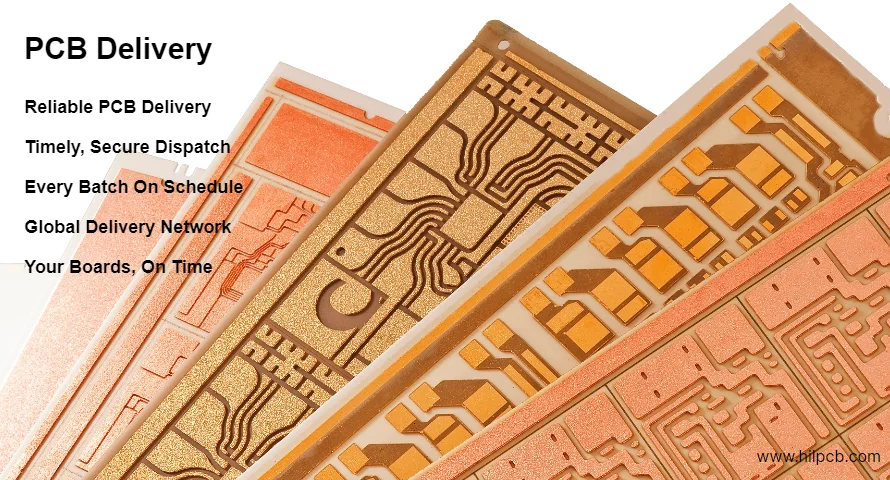Efficient PCB delivery is not limited to dispatching completed boards—it involves coordinating carrier selection, optimizing packaging standards, ensuring customs compliance, and maintaining visibility across the entire logistics chain.
Any disruption during this process—whether shipment delays or physical damage—can escalate costs, affect downstream assembly schedules, and weaken customer trust.
This guide outlines advanced strategies for PCB delivery optimization, helping you align logistics with your manufacturing and sourcing objectives for maximum reliability and cost efficiency.
For an overview of production scheduling, explore PCB lead time.
1. Understanding Delivery Timelines and Carrier Options
PCB delivery begins once manufacturing is complete and ends when the boards are verified at your facility. The timeline includes packaging, carrier pickup, transit, customs clearance (for international routes), and final arrival. Each stage requires deliberate management to balance speed, cost, and reliability.
Domestic Delivery
Domestic PCB logistics typically range from two to five business days depending on service level. Express couriers such as FedEx, UPS, and DHL offer overnight or two-day delivery at a 40–60% premium—ideal for prototypes or tight development cycles.
Standard ground shipping remains the most cost-effective option for non-urgent deliveries, reducing expenses by up to 50% while maintaining predictable schedules.
International Shipping
For cross-border shipments, complexity increases due to customs procedures and longer distances.
- Express air freight: 5–7 business days including customs, suitable for urgent production or samples.
- Standard air freight: 7–10 days, offering 40–50% lower cost than express services for routine shipments.
- Ocean freight: 3–6 weeks depending on routes, ideal for large production volumes above 50kg where schedule flexibility exists.
Selecting the right mode requires integrating logistics planning with production forecasting. Understanding your PCB cost structure ensures that shipping choices align with total cost of ownership rather than short-term savings.

2. Packaging Standards That Protect Product Integrity
Packaging serves as the final line of defense for PCB quality. Even minor packaging errors can result in damaged boards, corrosion, or ESD-related defects.
Bare PCB Packaging
Bare boards should be vacuum-sealed in anti-static moisture-barrier bags to prevent oxidation and humidity absorption. Layered protection—anti-static wrap, foam separators, and rigid cardboard—absorbs shock and minimizes flexing during transport.
Assembled PCB Protection
Assembled boards require additional protection for mounted components. Custom foam inserts and rigid trays immobilize assemblies, preventing mechanical stress on solder joints, connectors, or sensors. These precautions are especially critical for boards with uneven profiles or tall components.
Panel vs. Individual Board Shipment
Panelized shipment offers greater mechanical stability and cost efficiency but requires depanelization tools upon receipt. Individual boards, though more convenient, need reinforced packaging to prevent bending or edge damage.
Choosing between panel and single-board shipping depends on downstream handling capacity and your broader PCB procurement strategy.
Exterior labeling must clearly indicate orientation, fragility, and ESD warnings. For international shipments, attach documentation packets externally to simplify customs inspection and reduce clearance delays. Incorporating robust PCB shipping standards prevents post-production loss.
3. Navigating Customs and Cross-Border Documentation
International shipments require precise documentation to avoid customs delays.
The commercial invoice must include product descriptions, HS codes (8534.00 for printed circuits), declared value, and complete sender and recipient information.
Incorrect classification or valuation can result in multi-day clearance delays.
Duty and tax rates typically range from 5–15% of declared value, depending on destination and trade agreements. Certain jurisdictions exempt prototypes or low-value goods from import duties, but value-added tax (VAT) or GST may still apply.
Proper classification directly impacts total landed cost and overall PCB pricing consistency across projects.
Export control regulations also apply to specific PCB types, particularly those supporting encryption, RF transmission, or military-grade components. Ensuring compliance with ITAR or EAR (for U.S. exports) prevents legal and logistical complications.
When applicable, Certificates of Origin enable reduced tariffs through free trade agreements. Partnering with experienced freight forwarders simplifies document handling and optimizes your PCB logistics chain.

4. Tracking, Receiving, and Handling Delivery Issues
Visibility throughout transit is essential for operational predictability.
Modern express couriers provide real-time tracking updates for pickup, customs clearance, and delivery milestones, allowing proactive planning and immediate response to disruptions.
Freight shipments, with multiple handoffs, benefit from manual status verification through freight forwarders.
Upon receipt, inspect packaging for deformation or moisture intrusion before signing acceptance. Document visible damage with photos—this is essential for claims. For high-value shipments, establish internal receiving inspection protocols to verify board integrity before use.
Claims for shipping damage typically require notification within 24–48 hours of delivery and documentation of damage evidence. Supplementing carrier liability with comprehensive cargo insurance (1–3% of shipment value) protects against significant financial loss.
Integrating delivery data with your PCB inventory system enables traceability, demand forecasting, and contingency planning, ensuring that delivery incidents never disrupt ongoing production.
5. Building a Reliable Delivery Ecosystem
Optimizing PCB delivery means aligning logistics execution with manufacturing and sourcing decisions.
A reliable delivery network combines predictable transit times, robust packaging standards, accurate documentation, and transparent communication among all stakeholders.
Organizations that integrate delivery planning into the broader PCB supply chain achieve measurable reductions in cost variability and quality risk.
Consistent coordination between procurement, logistics, and production teams transforms PCB delivery from a transactional process into a strategic advantage.

